Subsidy as An Economic Instrument for Environmental Protection: A Case of Global Fertilizer Use
Abstract
:1. Introduction
2. Materials and Methods
2.1. Data Collection
2.2. Data Analysis
3. Results and Discussion
3.1. Subsidized Fertilizer Use and Crop Production
3.2. Income, Fertilizer Subsidy, and Food Safety Nexus
3.3. Cropland Cover and Food Production
3.4. Impacts of Environmental Factors on Food Security
3.5. Organic Fertilizer USE as a Sustainable Tool for Bioeconomy
4. Conclusions
Supplementary Materials
Author Contributions
Funding
Institutional Review Board Statement
Informed Consent Statement
Data Availability Statement
Acknowledgments
Conflicts of Interest
References
- Hu, J. The economic instruments for environmental protection of Chinese Taipei. In Proceedings of the APEC MRC Group Conference, Manila, Philippines, 22–23 November 1996. [Google Scholar]
- Organization for Economic and Co-operative Development (OECD). Managing the Environment: The Role of Economic Instruments. 1994. Available online: https://core.ac.uk/download/pdf/48031478.pdf (accessed on 9 January 2021).
- Liang, L.; Wang, Y.; Ridoutt, B.G.; Lal, R.; Wang, D.; Wu, W.; Wang, L.; Zhao, G. Agricultural subsidies assessment of cropping system from environmental and economic perspectives in North China based on LCA. Ecol. Indic. 2019, 96, 351–360. [Google Scholar] [CrossRef]
- International Fertilizer Association. 2016. Available online: http://www.fertilizer.org/Statistics (accessed on 11 January 2021).
- Lopez, R.A.; He, X.; Falcis, E.D. What drives China’s new agricultural subsidies? World Dev. 2017, 93, 279–292. [Google Scholar] [CrossRef] [Green Version]
- Mather, D.L.; Jayne, T.S. Fertilizer subsidy and the role of targeting in crowding out: Evidence from Kenya. Food Secur. 2018, 10, 397–417. [Google Scholar] [CrossRef]
- Chen, Y.; Chen, M.; Mishra, A.K. Subsidies under uncertainty: Modeling of input- and output-oriented policies. Econ. Model. 2020, 85, 39–56. [Google Scholar] [CrossRef]
- Hossain, M.; Singh, V.P. Fertilizer use in Asian agriculture: Implications for sustaining food security and the environment. Nutr. Cycl. Agroecosyst. 2000, 57, 155–169. [Google Scholar] [CrossRef]
- Wu, Y.; Wang, E.; Miao, C. Fertilizer use in China: The role of agricultural support policies. Sustainability 2019, 11, 4391. [Google Scholar] [CrossRef] [Green Version]
- Rakshit, M. Some economics of fertiliser subsidy. J. Quant. Econ. 2018, 16, S209–S228. [Google Scholar] [CrossRef]
- OECD. Agriculture and the Environment: Canada’s Response, Prepared by Agriculture Canada Environmental Bureau; OECD: Paris, France, 1993. [Google Scholar]
- OECD. Agricultural and Environmental Policies: Opportunities for Integration; OECD: Paris, France, 1989. [Google Scholar]
- Rolfe, C.J.B. Using Subsidies to Promote Environmental Protection in Agriculture: A Review of Programs in North America and Europe; West Coast Environmental Law Research Foundation: Victoria, BC, Canada, 1993. [Google Scholar]
- Runge, C.F. Environmental Effects of Trade in the Agricultural Sector: A Case Study. 1992. Available online: https://ageconsearch.umn.edu/record/14449/ (accessed on 13 June 2021).
- Adams, G.; Patrick, W.; Brian, W.; Robert, E.Y. Do “Decoupled” payments affect, U.S. crop area? Preliminary evidence from 1997–2000. Am. J. Agric. Econ. 2001, 83, 1190–1195. [Google Scholar] [CrossRef]
- Ervin, D.E. Agriculture, Trade and the Environment: Anticipating the Policy Challenges; OECD: Paris, France, 1997. [Google Scholar]
- Taheripour, F.; Khanna, M.; Nelson, H.C. Welfare impacts of alternative public policies for agricultural pollution control in an open economy: A general equilibrium framework. Am. J. Agric. Econ. 2010, 90, 701–718. [Google Scholar] [CrossRef]
- O’Connor, D. Applying economic instruments in developing countries: From theory to implementation. Environ. Dev. Econ. 1999, 4, 91–110. [Google Scholar] [CrossRef]
- Nunes, J.M.R.; Bonito, A.; Loures, L.; Gama, J.; López-Piñeiro, A.; Peña, D.; Albarrán, Á. Effects of the European Union agricultural and environmental policies in the sustainability of most common Mediterranean soils. Sustainability 2017, 9, 1404. [Google Scholar] [CrossRef] [Green Version]
- Vitalis, V. Agricultural subsidy reform and its implications for sustainable development: The New Zealand experience. Environ. Sci. 2007, 4, 21–40. [Google Scholar] [CrossRef] [Green Version]
- Sumner, D.A. American farms keep growing: Size, productivity, and policy. J. Econ. Perspect. 2014, 28, 147–166. [Google Scholar] [CrossRef] [Green Version]
- Wegren, S.K.; Frode, N.; Elvestad, C. The impact of Russian food security policy on the performance of the food system. Eur. Geogr. Econ. 2016, 57, 1–29. [Google Scholar] [CrossRef]
- Sckokai, P.; Moro, D. Modeling the reforms of the common agricultural policy for arable crops under uncertainty. Am. J. Agric. Econ. 2006, 88, 43–56. [Google Scholar] [CrossRef]
- Yi, F.J.; Sun, D.Q.; Zhou, E.H. Grain subsidy, liquidity constraints and food security impact of the grain subsidy program on the grain-sown areas in China. Food Policy 2016, 50, 114–124. [Google Scholar] [CrossRef]
- Antón, J.; Chantal, L.M. Do counter-cyclical payments in the 2002 US farm act create incentives to produce? Agric. Econ. 2004, 31, 277–284. [Google Scholar] [CrossRef]
- Kirwan, B.E.; Roberts, M.J. Who really benefits from agricultural subsidies? Evidence from field-level data. Am. J. Agric. Econ. 2016, 98, 1095–1113. [Google Scholar] [CrossRef]
- Mayrand, K.; Dionne, S.; Paquin, M.; Pageot-LeBel, I. The Economic and Environmental Impacts of Agricultural Subsidies: An Assessment of the 2002 US Farm Bill & Doha Round; Unisféra International Centre: Montreal, QC, Canada, 2013. [Google Scholar]
- Mayrand, K.; Marc, D.; Ortega, G.A.; Marrón, L.F.G. The Economic and Environmental Impacts of Agricultural Subsidies: A Look at Mexico and Other OECD Countries; Unisféra International Centre: Montreal, QC, Canada, 2013. [Google Scholar]
- Worldwatch Institute. Agricultural Subsidies Remain a Staple in the Industrial World. 2014. Available online: http://vitalsigns.worldwatch.org/vs-trend/agricultural-subsidies-remain-staple-industrial-world (accessed on 5 February 2021).
- FAO. Country Fact Sheet on Food and Agriculture Policy Trends. 2016. Available online: http://www.fao.org/3/a-i6054e.pdf (accessed on 10 February 2021).
- World Summit on Sustainable Development. The UN Plan of Implementation. 2002. Available online: http://www.johannesburgsummit.org/html/documents/summit_docs/2309_planfinal.htm (accessed on 7 February 2021).
- OECD. Environmentally Harmful Subsidies. 2005. Available online: https://www.oecd.org/site/agrehs/35217152.pdf (accessed on 15 January 2021).
- Dawson, C.J.; Hilton, J. Fertiliser availability in a resource-limited world: Production and recycling of nitrogen and phosphorus. Food Policy 2011, 36, S14–S22. [Google Scholar] [CrossRef]
- van Beers, C.; de Moor, A. Public Subsidies and Policy Failures: How Subsidies Distort the Natural Environment, Equity and Trade and How to Reform Them; Edward Elgar: Cheltenham, UK, 2001. [Google Scholar]
- Steenblik, R.P. Subsidy measurement and classification: Developing a common framework. In Environmentally Harmful Subsidies: Policy Issues and Challenges; OECD: Paris, France, 2003; pp. 101–141. [Google Scholar]
- Food and Agriculture Organization (FAO). Available online: http://www.fao.org/statistics/en/2016 (accessed on 6 June 2021).
- International Fertilizer Association. Production & International Trade, International Fertilizer Association. Regional Figures for MAP, DAP, and TSP. Available online: http://www.fertilizer.org/En/Statistics/PIT_Excel_Files.aspx (accessed on 26 January 2021).
- Food and Agriculture Organization. FAOSTAT Online Statistical Service 2017. Available online: http://www.faostat.fao.org (accessed on 10 June 2021).
- Pellegrinia, P.; Fernández, R.J. Crop intensification, land use, and on-farm energy-use efficiency during the worldwide spread of the green revolution. Proc. Natl. Acad. Sci. USA 2018, 115, 2335–2340. [Google Scholar] [CrossRef] [Green Version]
- Kibirige, J.S. Population growth, poverty and health. Soc. Sci. Med. 1997, 45, 247–259. [Google Scholar] [CrossRef]
- Foley, J.A.; Ramankutty, N.; Brauman, K.A.; Cassidy, E.S.; Gerber, J.S.; Johnston, M. Solutions for a cultivated planet. Nature 2011, 478, 337–342. [Google Scholar] [CrossRef] [Green Version]
- Chen, X.; Zeng, D.; Ying, X.; Fan, X. Perceptions, risk attitude and organic fertilizer investment: Evidence from rice and banana farmers in Guangxi, China. Sustainability 2018, 10, 3715. [Google Scholar] [CrossRef] [Green Version]
- Han, S.H.; An, J.Y.; Hwang, J.; Kim, S.B.; Park, B.B. The effects of organic manure and chemical fertilizer on the growth and nutrient concentrations of yellow poplar (Liriodendron tulipifera L.) in a nursery system. Forest Sci. Tech. 2016, 12, 137–143. [Google Scholar] [CrossRef] [Green Version]
- Wossen, T.; Gatiso, T.T.; Kassie, M. Estimating Returns to Fertilizer Adoption with Unobserved Heterogeneity: Evidence from Ethiopia; International Institute of Tropical Agriculture (IITA): Nairobi, Kenya, 2018. [Google Scholar]
- Attigah, A.S.; Asiedu, K.E.; Agyarko, K.; Dapaah, H.K. Growth and yield of okra (Abelmoschu sesculentus L.) as affected by organic and inorganic fertilizers. ARPN J. Agric. Biol. Sci. 2013, 8, 766–770. [Google Scholar]
- Dennis, E.A.; Anane-Sakyi, C.; Affi-Pungu, G. The effect of cow dung and mineral fertilisers on yield of dry season gardening of onion in the Upper East Region of Ghana. In Proceedings of the 1st National Workshop on Food and Industrial Crops, Kumasi, Ghana, 25–27 October 1994. [Google Scholar]
- Kanton, R.A.L.; Prasad, P.V.V.; Mohammed, A.M.; Bidzakin, J.K.; Ansoba, E.Y.; Asungre, P.A.; Sugri, I. Organic and inorganic fertilizer effects on the growth and yield of maize in a dry agro-ecology in Northern Ghana. J. Crop Improv. 2016, 30, 1–16. [Google Scholar] [CrossRef]
- Jones, D.L.; Cross, P.; Withers, P.J.A.; Deluca, T.H.; Robinson, D.A.; Quilliam, R.S. Nutrient stripping: The global disparity between food security and soil nutrient stocks. J. Appl. Ecol. 2013, 50, 851–862. [Google Scholar] [CrossRef]
- Tittonell, P.; Giller, K.E. When yield gaps are poverty traps: The paradigm of ecological intensification in African smallholder agriculture. Field Crops Res. 2013, 143, 76–90. [Google Scholar] [CrossRef] [Green Version]
- Ali, E.B.; Awuni, J.A.; Danso-Abbeam, G. Determinants of fertilizer adoption among smallholder cocoa farmers in the western region of Ghana. Cogent Food Agric. 2018, 4, 1538. [Google Scholar] [CrossRef]
- Gedefaw, A.; Sisay, D. Factors affecting use of organic fertilizer among smallholder farmers in Sekela district of Amhara region, Northwestern Ethiopia. Cogent Food Agric. 2019, 5, 1669398. [Google Scholar] [CrossRef]
- Chianu, J.N.; Chianu, N.J.; Mairura, F. Organic fertilizers in Sub-Saharan farming systems. In Sustainable Agriculture Reviews; Springer: Berlin, Germany, 2012; Volume 9. [Google Scholar]
- Tropical Soil Biology and Fertility Institute. Integrated Soil Fertility Management in Africa: Principles, Practices and Developmental Process; CIAT: Cali, Colombia, 2009; p. 263. [Google Scholar]
- Cedrez, B.C.; Chamberlin, J.; Guo, Z.; Hijmans, R.J. Spatial variation in fertilizer prices in Sub-Saharan Africa. PLoS ONE 2020, 15, e0227764. [Google Scholar] [CrossRef] [Green Version]
- Harris, F. Management of manure in farming systems in semi-arid West Africa. Exp. Agric. 2002, 38, 131–148. [Google Scholar] [CrossRef]
- Food and Agriculture Organization of the United Nations (FAO). FAOSTAT Inputs/Fertilizers by Nutrient, and FAOSTAT Inputs Land Use. 2020. Available online: http://www.fao.org/faostat/en/?#data (accessed on 2 April 2021).
- Food and Agriculture Organization. FAOSTAT Database 2019. Available online: http://www.fao.org/faostat/en/#data (accessed on 15 February 2021).
- Food and Agriculture Organization of the United Nations. FAO Soils Portal FAO/UNESCO Soil Map of the World. Available online: http://www.fao.org/soils-portal/data-hub/soil-maps-and-databases/faounesco-soil-map-of-the-world/en/ (accessed on 8 April 2021).
- Forest Resources Assessment (FRA). Report and Database on World Forest Resources. Available online: http://www.fao.org/forest-resources-assessment/en/ (accessed on 10 February 2021).
- World Bank. World Development Indicators. Available online: http://data.worldbank.org/datacatalog (accessed on 2 January 2021).
- World Bank Groups. Database on Literacy Rate. Available online: https://data.worldbank.org/indicator/SE.ADT.LITR.ZS (accessed on 4 January 2021).
- World Income Inequalities Databases (WID). Available online: https://wid.world/ (accessed on 20 February 2021).
- National Aeronautics and Space Administration (NASA). Available online: https://www.neo.sci.gsfc.nasa.gov (accessed on 7 January 2021).
- Global Soil Data Task Group (GSDTG). Global Gridded Surfaces of Selected Soil Characteristics (IGBP-DIS). Available online: http://www.daac.ornl.gov/cgi-bin/dsviewer.pl?ds_id=569 (accessed on 15 January 2021).
- ISRIC. WoSIS Soil Profile Database. Available online: https://www.isric.org/explore/wosis (accessed on 3 March 2021).
- Harttgen, K.; Vollmer, S. Inequality decomposition without income or expenditure data using an asset index to simulate household income. In Human Development Research; UNDP: New York, NY, USA, 2011. [Google Scholar]
- Salem, N.; Hussein, S. Data dimensional reduction and principal components analysis. Procedia Comput. Sci. 2019, 163, 292–299. [Google Scholar] [CrossRef]
- Nguyen, L.H.; Holmes, S. Ten quick tips for effective dimensionality reduction. PLoS Comput. Biol. 2019, 15, e1006907. [Google Scholar] [CrossRef] [PubMed] [Green Version]
- ESRI. ArcGIS Desktop: Release 10; Environmental Systems Research Institute: Redlands, CA, USA, 2019. [Google Scholar]
- Crawford, E.W.; Jayne, T.S.; Kelly, V.A. Alternative Approaches for Promoting Fertilizer Use in Africa, with Particular Reference to the Role of Fertilizer Subsidies; Department of Agricultural Economics Michigan State University: East Lansing, MI, USA, 2005. [Google Scholar]
- Stewart, Z.P.; Pierzynski, G.M.; Middendorf, J.; Prasad, V. Approaches to improve soil fertility in Sub-Saharan Africa. J. Exp. Bot. 2020, 71, 632–641. [Google Scholar] [CrossRef] [Green Version]
- Bationo, A.; Ntare, B.R.; Tarawali, S.A.; Tabo, R. Soil fertility management and cowpea production in the semiarid tropics. In Challenges and Opportunities for Enhancing Sustainable Cowpea Production; Fatokun, C., Tarawali, S., Singh, B., Kormawa, P., Tamo, M., Eds.; IITA: Ibadan, Nigeria, 2002; pp. 301–318. [Google Scholar]
- Vanlauwe, B.; Bationo, A.; Chianu, J.; Giller, K.E.; Merckx, R.; Mokwunye, U.; Ohiokpehai, O.; Pypers, P.; Tabo, R.; Shepherd, K.D. Integrated soil fertility management: Operational definition and consequences for implementation and dissemination. Outlook Agric. 2010, 39, 17–24. [Google Scholar] [CrossRef] [Green Version]
- Vanlauwe, B.; Wendt, J.; Diels, J. Combined application of organic matter and fertilizer. In Sustaining Soil Fertility in West Africa; American Society of Agronomy: Madison, WI, USA, 2001. [Google Scholar]
- Watson, M. Agricultural infrastructure development imperative for sustainable food production: A Zimbabwean perspective. Russ. J. Agric. Soc. Econ. Sci. 2013, 24, 13–21. [Google Scholar]
- Gouache, D.; Bris, X.L.; Bogard, M.; Deudon, O.; Pagé, C.; Gate, P. Evaluating agronomic adaptation options to increasing heat stress under climate change during wheat grain filling in France. Europ. J. Agron. 2012, 39, 62–70. [Google Scholar] [CrossRef]
- Bennett, D.J.; Jennings, R.C. Successful Agricultural Innovation in Emerging Economies; Cambridge University Press: Cambridge, UK, 2013. [Google Scholar]
- Komarek, A.M.; Drogue, S.; Chenoune, R.; Hawkins, J.; Msangi, S.; Belhouchette, H.; Flichman, G. Agricultural household effects of fertilizer price changes for smallholder farmers in central Malawi. Agric. Syst. 2017, 154, 168–178. [Google Scholar] [CrossRef]
- Akram, U.; Metson, G.S.; Quttineh, N.H.; Wennergren, U. Closing Pakistan’s yield gaps through nutrient recycling. Front. Sustain. Food Syst. 2018, 2, 24. [Google Scholar] [CrossRef] [Green Version]
- Kannan, P.; Paramasivan, M.; Marimuthu, S.; Swaminathan, C.; Jayakumar, B. Applying both biochar and phosphobacteria enhances Vigna mungo L. growth and yield in acid soils by increasing soil pH, moisture content, microbial growth and P availability. Agric. Ecosyst. Environ. 2021, 308, 107258. [Google Scholar] [CrossRef]
- Vico, A.; Sáez, J.A.; Pérez-Murcia, M.D.; Martinez-Tomé, J.; Andreu-Rodríguez, J.; Agulló, E.; Bustamante, M.A.; Sanz-Cobena, A.; Moral, R. Production of spinach in intensive Mediterranean horticultural systems can be sustained by organic-based fertilizers without yield penalties and with low environmental impacts. Agric. Syst. 2020, 178, 102765. [Google Scholar] [CrossRef]
- Correndo, A.A.; Rotundo, J.S.; Nicolas, T.; Sotirios, A.; Jeffrey, A.; Dorivar Ruiz-Diaz, C.; Franzen, D.; Franzluebbers, A.J.; Emerson, N.; Schwalbert, R.; et al. Assessing the uncertainty of maize yield without nitrogen fertilization. Field Crops Res. 2021, 260, 107985. [Google Scholar] [CrossRef]
- Fontana, M.B.; Novelli, L.E.; Sterren, M.A.; Uhrich, W.G.; Benintende, S.M.; Barbagelata, P.A. Long-term fertilizer application and cover crops improve soil quality and soybean yield in the Northeastern Pampas region of Argentina. Geoderma 2021, 385, 114902. [Google Scholar] [CrossRef]
- Tibbett, M.; Daws, M.I.; George, S.J.; Ryan, M.H. The where, when and what of phosphorus fertilisation for seedling establishment in a biodiverse jarrah forest restoration after bauxite mining in Western Australia. Ecol. Eng. 2020, 153, 105907. [Google Scholar] [CrossRef]
- Scholz, R.W.; Geissler, B. Feebates for dealing with trade-offs on fertilizer subsidies: A conceptual framework for environmental management. J. Clean. Prod. 2018, 189, 898–909. [Google Scholar] [CrossRef]
- Yan, Z.; Liu, P.; Li, Y.; Ma, L.; Alva, A.; Dou, Z.; Zhang, F. Phosphorus in China’s intensive vegetable production systems: Overfertilization, soil enrichment, and environmental implications. J. Environ. Qual. 2013, 42, 982–989. [Google Scholar] [CrossRef]
- Heffer, P.; Prud’homme, M. Fertilizer outlook 2015–2019. In Proceedings of the IFA Annual Conference, Instanbul, Turkey, 25–27 May 2015. [Google Scholar]
- Hofstetter, P.; Müller-Wenk, R. Monetization of health damages from road noise with implications for monetizing health impacts in life cycle assessment. J. Clean. Prod. 2015, 13, 1235–1245. [Google Scholar] [CrossRef]
- Ju, X.T.; Gu, B.J. Status-quo, problem and trend of nitrogen fertilization in China. J. Plant Nutr. Fert. Sci. 2014, 20, 783–795. [Google Scholar]
- Denning, G.; Kabambe, P.; Sanchez, A.; Malik, R.; Flor, R.; Harawa, P.; Nkhoma, C.; Zamba, C.; Banda, C.; Magombo, M.; et al. Input subsidies to improve smallholder maize productivity in Malawi: Toward an African green revolution. PLoS Biol. 2009, 7, e1000023. [Google Scholar] [CrossRef] [Green Version]
- Gaba, S.; Lescourret, F.; Boudsocq, S.; Enjalbert, J.; Hinsinger, P.; Journet, E.P.; Navas, M.L.; Wery, J.; Louarn, G.; Malézieux, E.; et al. Multiple cropping systems as drivers for providing multiple ecosystem services: From concepts to design. Agron. Sustain. Dev. 2015, 35, 607–623. [Google Scholar] [CrossRef] [Green Version]
- Waha, K.; Dietrich, J.P.; Portmann, F.T.; Siebert, S.; Thornton, P.K.; Bondeau, A.; Herrero, M. Multiple cropping systems of the world and the potential for increasing cropping intensity. Glob. Environ. Chang. 2020, 64, 102131. [Google Scholar] [CrossRef] [PubMed]
- Ray, D.K.; Foley, J.A. Increasing global crop harvest frequency: Recent trends and future directions. Environ. Res. Lett. 2013, 10, 44041. [Google Scholar] [CrossRef]
- Wu, W.; Yu, Q.; You, L.; Chen, K.; Tang, H.; Liu, J. Global cropping intensity gaps: Increasing food production without cropland expansion. Land Use Policy 2018, 76, 515–525. [Google Scholar] [CrossRef]
- Qiu, J.; Tang, H.; Frolking, S.; Boles, S.; Li, C.; Xiao, X.; Liu, J.; Zhuang, Y.; Qin, X. Mapping single-, double-, and triple-crop agriculture in china at 0.5° × 0.5° by combining county-scale census data with a remote sensing-derived land cover map. Geocarto Int. 2003, 18, 3–13. [Google Scholar] [CrossRef]
- Government of India. Agricultural Statistics at a Glance 2016; Government of India: New Delhi, India, 2016.
- Teklewold, H.; Kassie, M.; Shiferaw, B.; Köhlin, G. Cropping system diversification, conservation tillage and modern seed adoption in Ethiopia: Impacts on household income, agrochemical use and demand for labor. Ecol. Econ. 2013, 93, 85–93. [Google Scholar] [CrossRef]
- Waha, K.; Herrero, M. Multiple Cropping Could Help Feed the World. Available online: https://ccafs.cgiar.org/news/multiple-cropping-could-help-feed-world (accessed on 16 January 2021).
- Mayberry, D.; Hau, D.K.; Dida, P.R.; Bria, D.; Praing, J.; Mata, A.D.; Budisantoso, E.; Dalgliesh, N.; Quigley, S.; Bell, L.; et al. Herbaceous legumes provide several options for increasing beef cattle productivity in eastern Indonesia. Anim. Prod. Sci. 2021, 61, 20545. [Google Scholar] [CrossRef]
- Failla, S.; Pirchio, M.; Sportelli, M.; Frasconi, C.; Fontanelli, M.; Raffaelli, M.; Peruzzi, A. Evolution of smart strategies and machines used for conservative management of herbaceous and horticultural crops in the Mediterranean basin: A review. Agronomy 2021, 11, 106. [Google Scholar] [CrossRef]
- Zalesny, R.S.; Stanturf, J.A.; Gardiner, E.S.; Perdue, J.H.; Young, T.M.; Coyle, D.R.; Headlee, W.L.; Bañuelos, G.S.; Hass, A. Ecosystem services of woody crop production systems. Bioenergy Res. 2016, 9, 465–491. [Google Scholar] [CrossRef] [Green Version]
- Pleguezuelo, C.R.R.; Zuazo, V.H.D.; Bielders, C.; Bocanegra, J.A.J.; Perea Torres, F.; Martínez, J.R.F. Bioenergy farming using woody crops. A review. Agron. Sustain. Dev. 2015, 35, 95–119. [Google Scholar] [CrossRef] [Green Version]
- Jorgenson, K.; Ryan, P.; Clark, T.B.; Givens, J.E.; Hill, T.D.; Huang, X.; Kelly, O.M.; Fitzgerald, J.B. Inequality amplifies the negative association between life expectancy and air pollution: A cross-national longitudinal study. Sci. Total Environ. 2021, 758, 143705. [Google Scholar] [CrossRef]
- Mohammadbeigi, A.; Khazaei, S.; Veisani, Y.; Delpisheh, A.; Jenabi, E. Global inequality in the incidence and mortality rate of melanoma skin cancer according to human development index: A country-level analysis. Egypt J. Dermatol. Venerol. 2021, 41, 26–31. [Google Scholar]
- Huh, H.S.; Park, C.Y. A new index of globalisation: Measuring impacts of integration on economic growth and income inequality. World Econ. 2020, 44, 409–443. [Google Scholar] [CrossRef]
- Gutiérrez-Romero, R.; Ahamed, M. COVID-19 response needs to broaden financial inclusion to curb the rise in poverty. World Dev. 2021, 138, 105229. [Google Scholar] [CrossRef]
- Henderson, K.; Loreau, M. Unequal access to resources undermines global sustainability. Sci. Total Environ. 2021, 763, 142981. [Google Scholar] [CrossRef]
- Blampied, N. Economic growth, environmental constraints and convergence the declining growth premium for developing economies. Ecol. Econ. 2021, 181, 106919. [Google Scholar] [CrossRef]
- Liverpool-Tasie, S. Fertilizer subsidies and private market participation: The case of Kano state, Nigeria. Agric. Econ. 2014, 45, 1–16. [Google Scholar] [CrossRef]
- Holden, S.T. Fertilizer and sustainable intensification in Sub-Saharan Africa. Glob. Food Secur. 2018, 18, 20–26. [Google Scholar] [CrossRef]
- Najafi, E.; Devineni, N.; Khanbilvardi, R.M.; Kogan, F. Understanding the changes in global crop yields through changes in climate and technology. Earths Future 2018, 6, 410–427. [Google Scholar] [CrossRef]
- Sinare, B.; Miningou, A.; Nebié, B.; Eleblu, J.; Kwadwo, O.; Traoré, A.; Zagre, B.; Desmae, H. Participatory analysis of groundnut (Arachis hypogaea L.) cropping system and production constraints in Burkina Faso. J. Ethnobiol. Ethnomed. 2021, 17. [Google Scholar] [CrossRef]
- Xu, X.; Liu, H.; Jiao, F.; Ren, Y.; Gong, H.; Lin, Z.; Huang, C. Influence of climate change and human activity on total nitrogen and total phosphorus: A case study of Lake Taihu, China. Lake Reserv. Manag. 2020, 36, 186–202. [Google Scholar] [CrossRef]
- Jose, C.P.; Tania, C.; Maribela, P. Evaluation of carob tree productivity during a 30-Year Period, in relation to precipitation and air temperature. Environ. Proc. Int. J. 2020, 7, 1221–1233. [Google Scholar]
- Rehman, A.; Jingdong, L.; Kabir, A.; Hussain, I. Effects of wheat yield and area under wheat crop on agricultural GDP in Pakistan: An econometric analysis. Int. J. Adv. Appl. Sci. 2017, 4, 137–141. [Google Scholar]
- Singh, G.; Nelson, K.A. Long-term drainage, subirrigation, and tile spacing effects on maize production. Field Crops Res. 2021, 262, 108032. [Google Scholar] [CrossRef]
- Olabanji, M.F.; Ndarana, T.; Davis, N. Impact of climate change on crop production and potential adaptive measures in the olifants catchment, South Africa. Climate 2021, 9, 6. [Google Scholar] [CrossRef]
- Gao, J.; Yan, Y.; Hou, X.; Liu, X.; Zhang, Y.; Huang, S.; Wang, P. Vertical distribution and seasonal variation of soil moisture after drip-irrigation affects greenhouse gas emissions and maize production during the growth season. Sci. Total Environ. 2021, 763, 142965. [Google Scholar] [CrossRef] [PubMed]
- Macdonald, B.C.T.; Nachimuthu, G.; Chang, Y.F.; Nadelko, A.J.; Tuomi, S.; Watkins, M. Nitrogen composition in furrow irrigated run-off water. Agric. Water Manag. 2020, 242, 106399. [Google Scholar] [CrossRef]
- Anwar, M.; Patra, D.D.; Chand, S.; Alpesh, K.; Naqvi, A.A.; Khanuja, S.P.S. Effect of organic manures and inorganic fertilizer on growth, herb and oil yield, nutrient accumulation, and oil quality of French basil. Commun. Soil Sci. Plant Anal. 2005, 36, 1737–1746. [Google Scholar] [CrossRef]
- Oenema, O. Government policies and measures regulating nitrogen and phosphorus from animal manure in European agriculture. J. Anim. Sci. 2004, 82, 196–206. [Google Scholar]
- NRCS-USDA. Draft Comprehensive Nutrient Management Planning Technical Guidance. Available online: https://www.nrca.usda.gov/programs/afo/cnmp_guide_600.50.html (accessed on 3 March 2021).
- Huang, J.; Wang, X.; Rozelle, S. The subsidization of farming households in China’s agriculture. Food Policy 2013, 41, 124–132. [Google Scholar] [CrossRef]
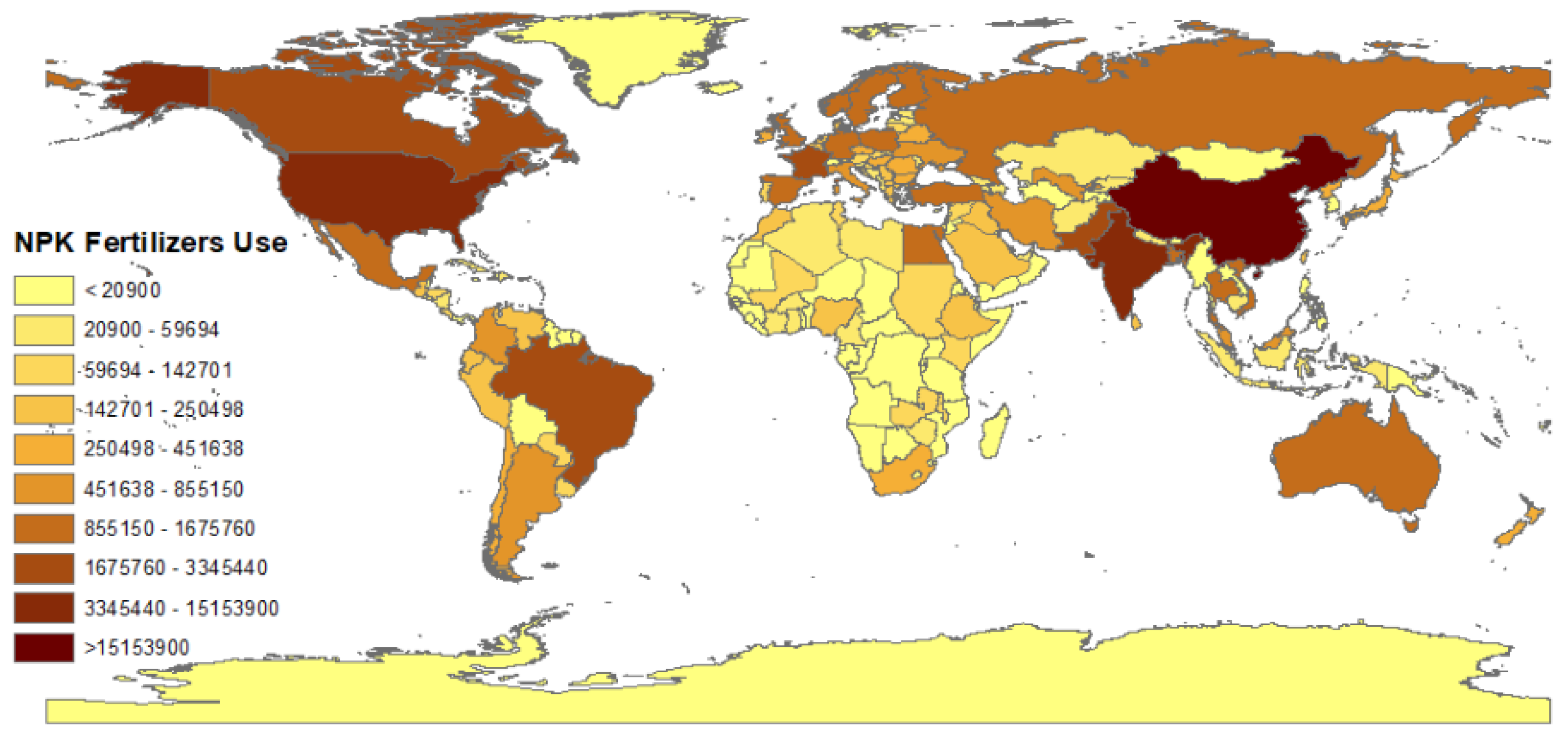
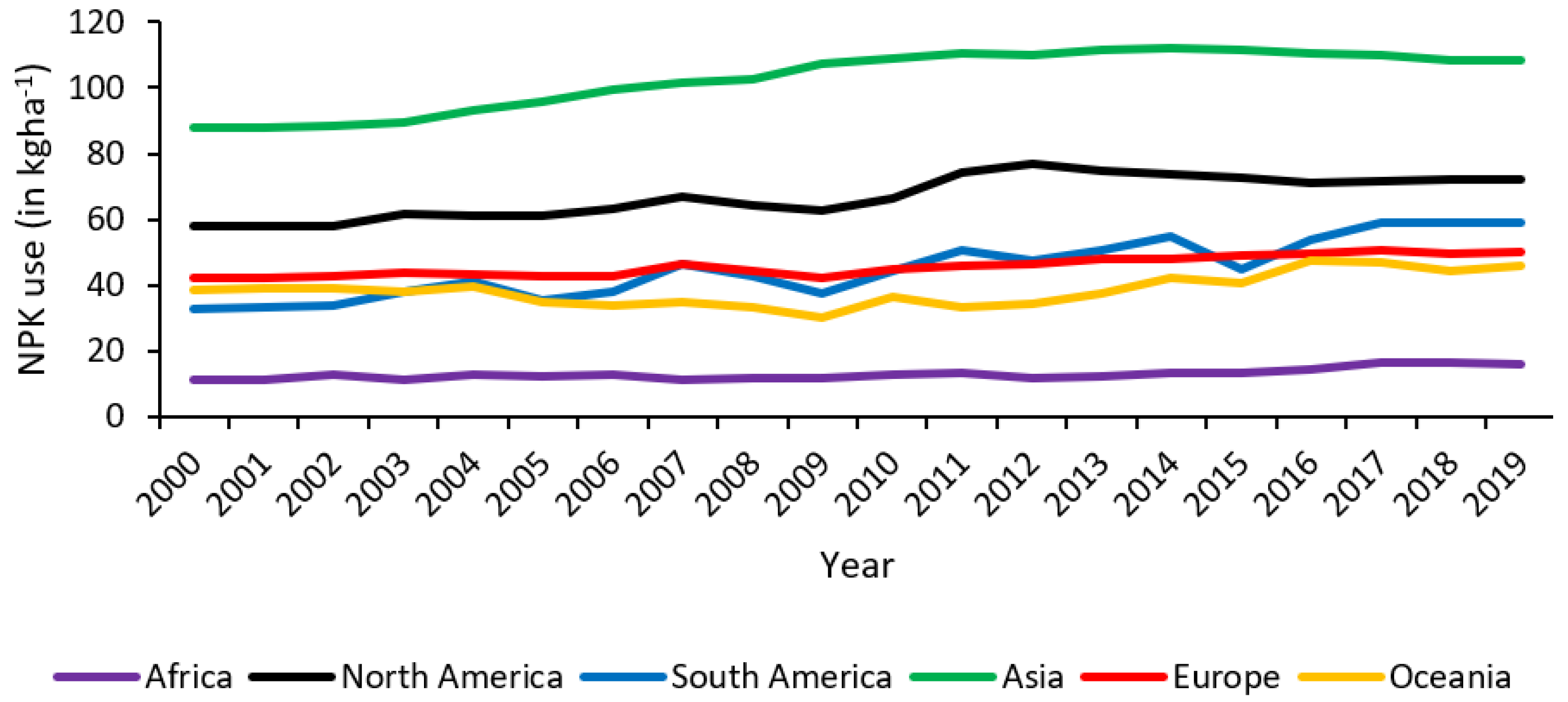
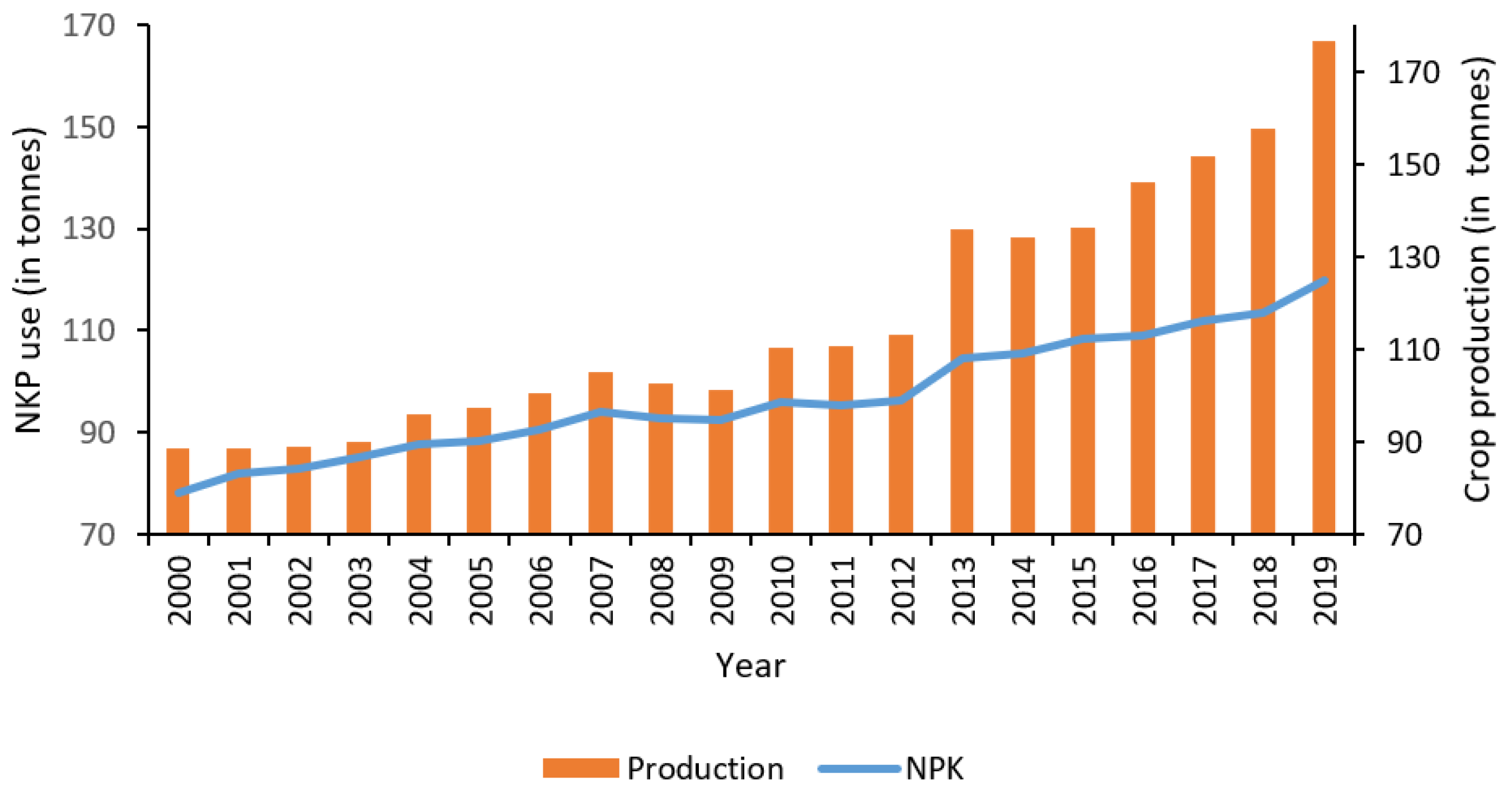

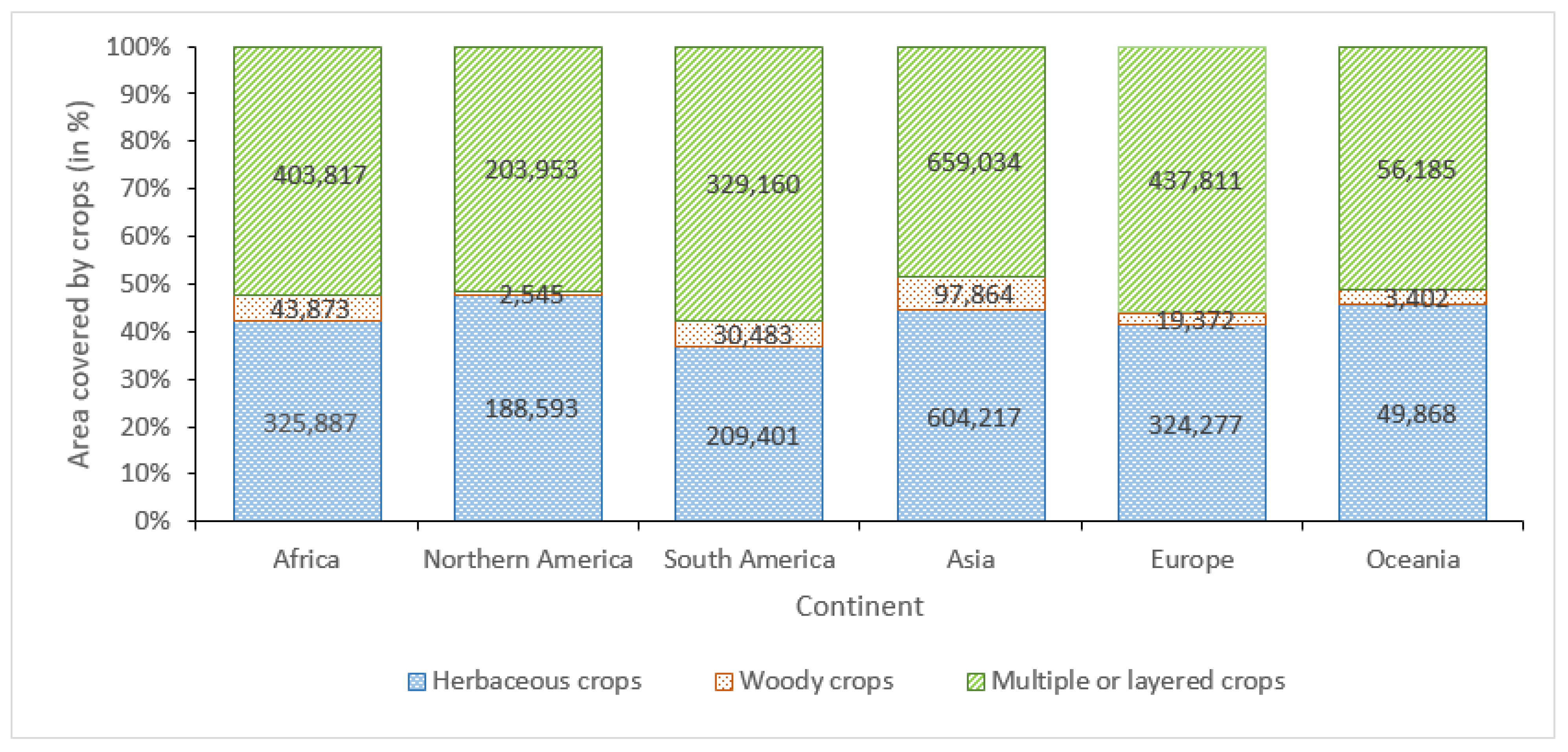
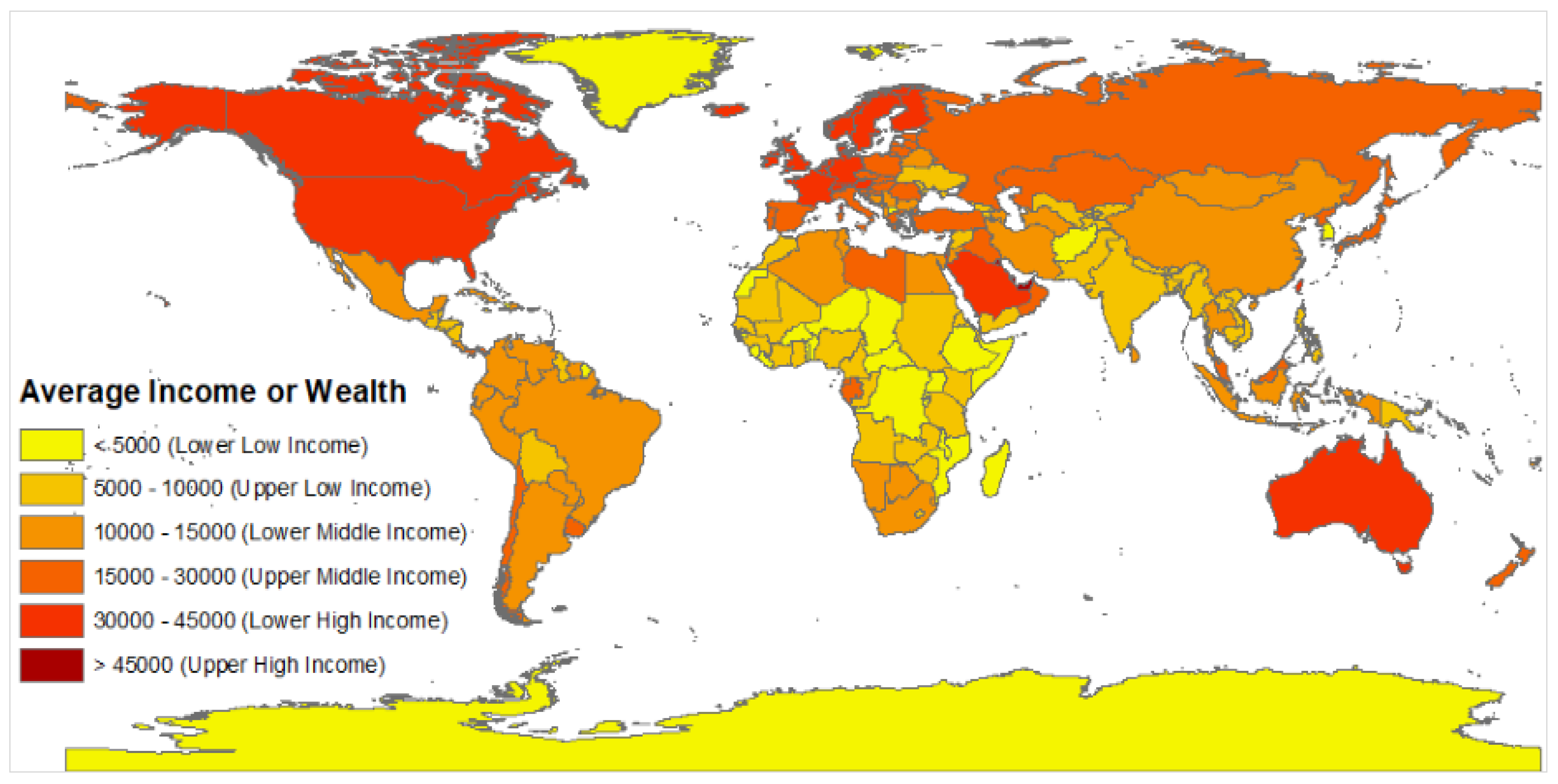
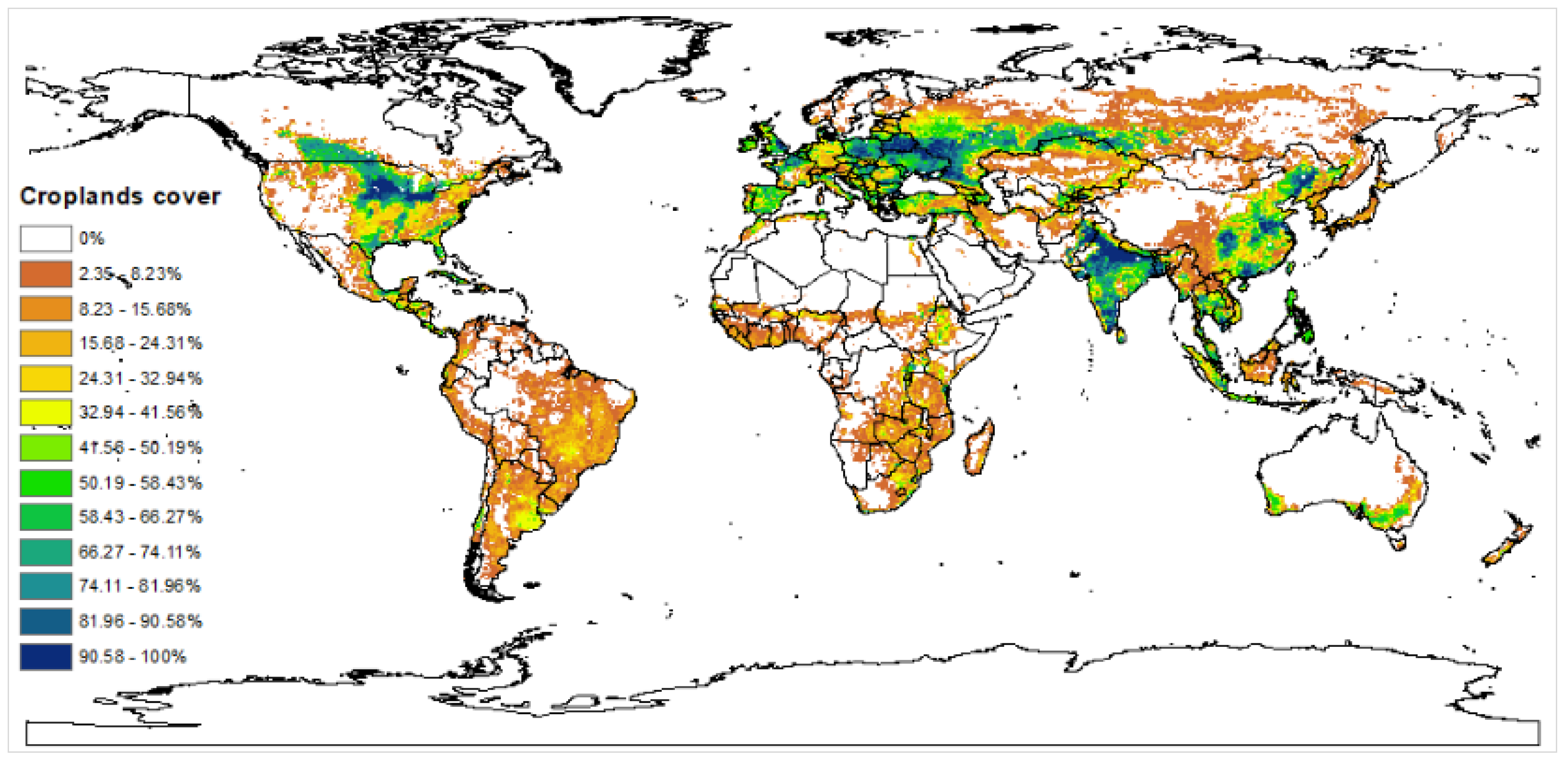
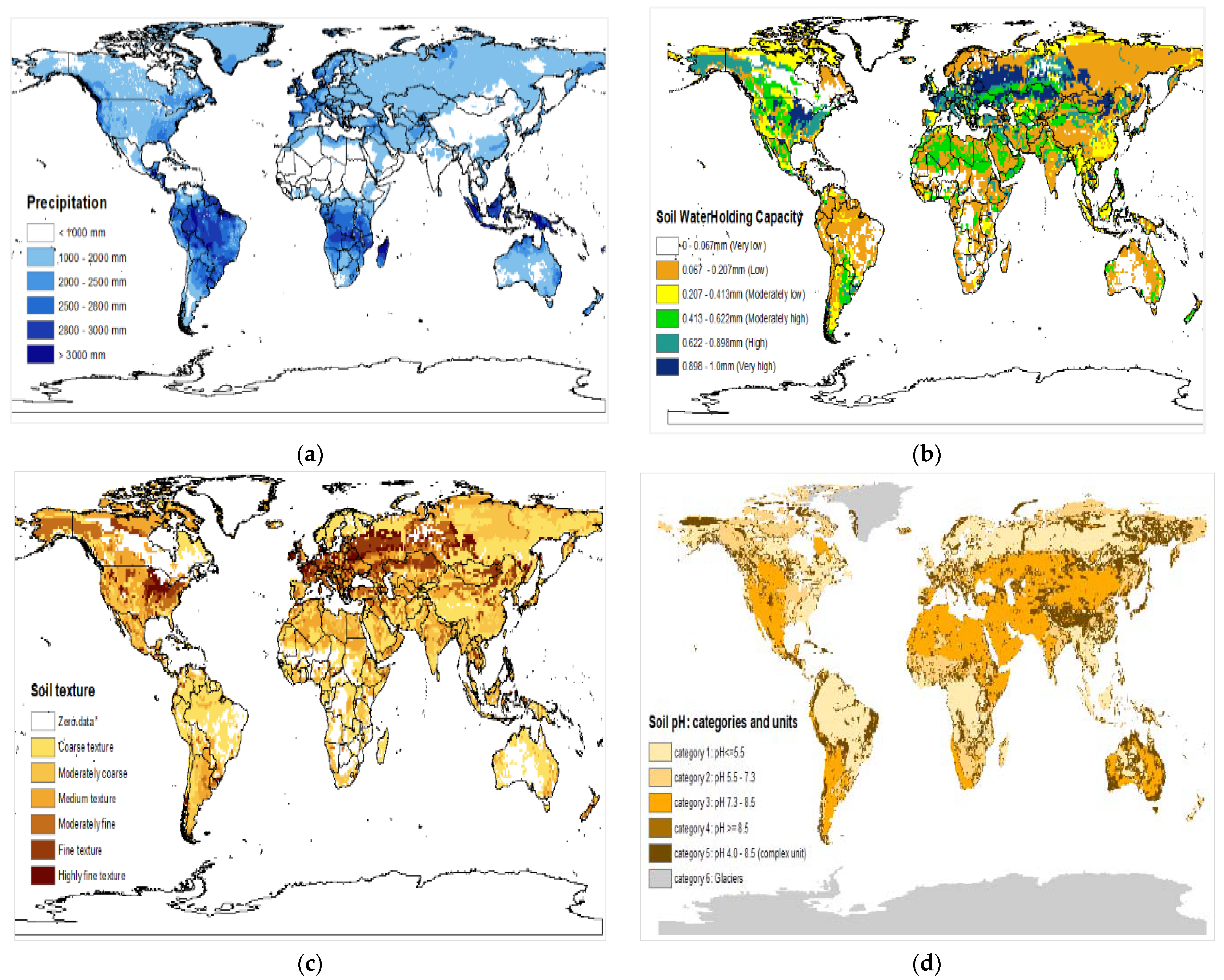
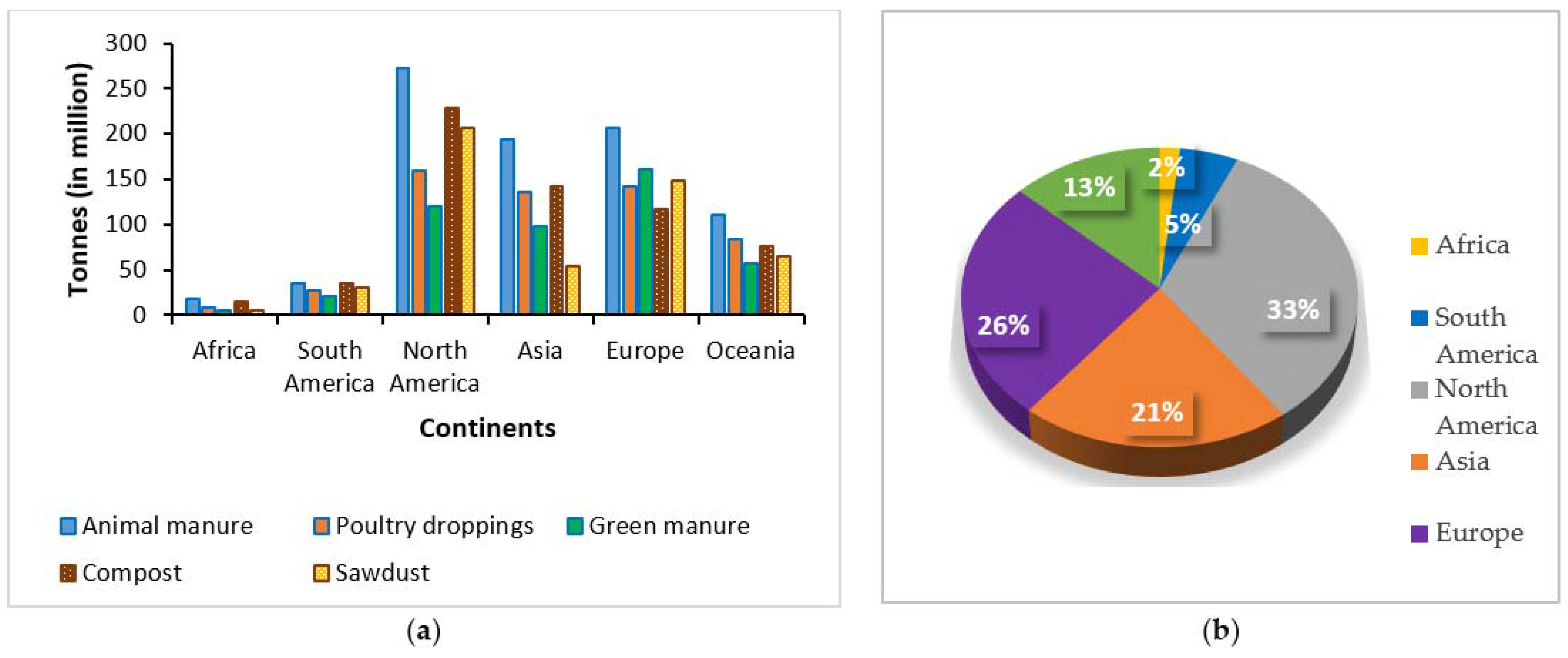
| Parameters | Fertilizer Use | CropProdQty | Crop Types | Income | CroplandCover | Temperature | Precipitation | Soil pH | Soil WHC | Soil Texture | GDP | Food Import | Food Export |
|---|---|---|---|---|---|---|---|---|---|---|---|---|---|
| Fertilizer Use | 1.00 | ||||||||||||
| CropProdQty | 0.93 * | 1.00 | |||||||||||
| Crop Types | 0.03 | 0.68 * | 1.00 | ||||||||||
| Income | 0.61 ** | 0.50 * | 0.05 | 1.00 | |||||||||
| CroplandCover | 0.07 | 0.82 ** | 0.00 | 0.74 * | 1.00 | ||||||||
| Temperature | 0.19 | 0.66 * | 0.58 * | 0.23 * | 0.00 | 1.00 | |||||||
| Precipitation | 0.58 | 0.73 ** | 0.69 * | −0.07 | 0.00 | −0.14 | 1.00 | ||||||
| Soil pH | 0.60 * | 0.51 * | 0.06 | 0.00 | 0.00 | 0.00 | 0.05 | 1.00 | |||||
| Soil WHC | 0.32 | 0.45 * | 0.01 | 0.00 | 0.00 | −0.09 | −0.67 * | 0.50 | 1.00 | ||||
| Soil Texture | 0.02 | 0.61 * | 0.00 | 0.11 | 0.00 | 0.00 | 0.02 | 0.33 | 0.88 * | 1.00 | |||
| GDP | 0.67 * | 0.91 * | 0.00 | 0.83 * | 0.37 * | 0.25 | 0.00 | 0.00 | 0.04 | 0.00 | 1.00 | ||
| Food Import | −0.55 | −0.12 | 0.00 | −0.44 | 0.16 | 0.00 | 0.00 | 0.00 | 0.01 | 0.07 | 0.00 | 1.00 | |
| Food Export | 0.63 | 0.57 * | 0.00 | 0.75 * | 0.59 ** | 0.00 | 0.23 | 0.00 | 0.35 | 0.14 | 0.79 * | −0.51 | 1.00 |
Publisher’s Note: MDPI stays neutral with regard to jurisdictional claims in published maps and institutional affiliations. |
© 2021 by the authors. Licensee MDPI, Basel, Switzerland. This article is an open access article distributed under the terms and conditions of the Creative Commons Attribution (CC BY) license (https://creativecommons.org/licenses/by/4.0/).
Share and Cite
Sane, M.; Hajek, M.; Nwaogu, C.; Purwestri, R.C. Subsidy as An Economic Instrument for Environmental Protection: A Case of Global Fertilizer Use. Sustainability 2021, 13, 9408. https://doi.org/10.3390/su13169408
Sane M, Hajek M, Nwaogu C, Purwestri RC. Subsidy as An Economic Instrument for Environmental Protection: A Case of Global Fertilizer Use. Sustainability. 2021; 13(16):9408. https://doi.org/10.3390/su13169408
Chicago/Turabian StyleSane, Mathy, Miroslav Hajek, Chukwudi Nwaogu, and Ratna Chrismiari Purwestri. 2021. "Subsidy as An Economic Instrument for Environmental Protection: A Case of Global Fertilizer Use" Sustainability 13, no. 16: 9408. https://doi.org/10.3390/su13169408






